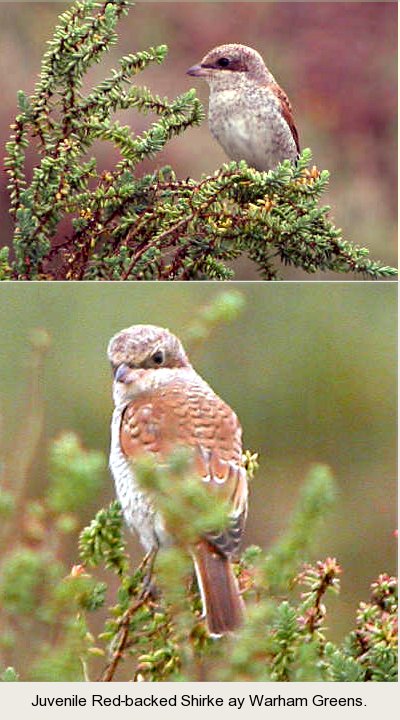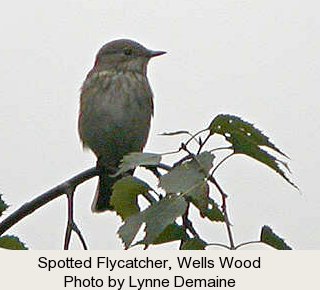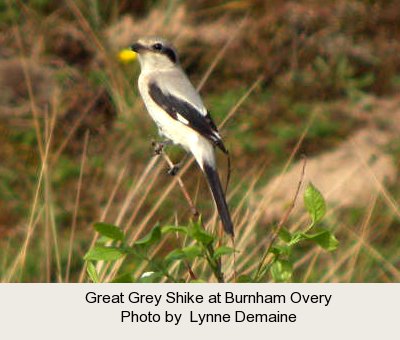Nottinghamshire Birdwatchers' Birdseekers
Norfolk 17th September 2006
Trip Report by Neil Glenn
Photographs by Lynne Demaine
Lynne (our esteemed Membership Secretary) and her husband Ron had ticked off several lifers before it had even got light this morning. Unfortunately, this was due to the fact that they had overslept and were dreaming of Siberian Rubythroats, Spoon-billed Sandpipers, Olive Tree Warblers and the likes. The rest of us were sitting in the minibus waiting for them at the allotted time of 0530! A short time later we picked them up en route to Norfolk. The merciless ribbing we could give them for the rest of the day was well worth the wait.
We arrive at Cley beach car park before 9.00am and take our position on the shingle bank in readiness for a seawatch. A few Common Scoters headed west along with good numbers of Wigeon and Teal. A moulting Red-throated Diver performed well for us just offshore. A good start.

Our attention was drawn to a skua chasing a Sandwich Tern to our right. The skua hassled the daintier bird into dropping its fish breakfast and caught the prize in mid air. What a spectacular display! By its heavy build, bulging chest, large two-toned bill and broad wings it was obvious the pirate we were watching was a Pomarine Skua. For comparison, three Arctic Skuas zipped east a few minutes later.
Andy latched on to a shearwater but I couldn’t get on to it until it was flying directly away in the distance. Those that saw it better than I describe the salient features of a Balearic Shearwater to me and it certainly looks dingier and slightly larger than a Manx on the poor views I obtain. The hardy group of seawatchers next to us are calling it as a Balearic so it looks like I have missed out on a good year tick!
After an interesting hour gazing out at sea, we move along the coast to Warham Greens. As we emerge from the bus, we can hear very loud music, seemingly emanating from the marsh! It turns out that there is a rave taking place in a disused barn.
We join a small flock of birdwatchers and settle down to admire the handsome juvenile Red-backed Shrike perched before us. The background Techno music lends a surreal atmosphere to proceedings.
The shrike poses for photos before dropping into cover, and then appears a few yards further along the edge of the marsh. We take our fill then walk a few yards further on to try and find the Wryneck. It was last seen flying into a small area of gorse and grass around ‘The Gibbet’ so I am confident of us catching a glimpse of this cryptically–plumaged beauty.
After a birdless hour’s stake—out, we decide to move position. Just as we move, I sense the group next to us are watching something, and sure enough there’s the Wryneck perched atop a bramble. I wave our group back and one or two see the little tease before it drops deep into the gorse. We wait around for a further half an hour but our prize fails to show again. How frustrating
The umps–a–umps–a–umps–a beat of dance music is still shaking the floor as we drive away to the next destination: Wells Woods. A Red–breasted Flycatcher has just shown in The Dell. We are on site within fifteen minutes, arriving to find several satisfied–looking birders leaving the wood
We scan the trees for this dainty bird. A burst of activity sees us examining a couple of Spotted Flycatchers flitting to and fro at the back of the plantation before a few of our group catch a glimpse of the Red-breasted Flycatcher. It perches head on to us for a couple of seconds before vanishing with the rest of the flock. The wood falls silent.

We move a few yards and find the Spotted Flycatchers again. They dart around causing great excitement every time they land. After half an hour of this, we begin to doubt that the Red-breasted is with them. A Pied Flycatcher briefly appears to add more excitement
The proprietor of Wildsounds rushes by and proclaims he has heard the RBF nearby. Suddenly, the wood is alive with birds. A feeding flock of Long-tailed, Blue, Coal and Great Tits move through the trees, joined by Chaffinches and Goldcrests. I am sure I can see the vent of the RBF but the rest of the bird is obscured by foliage. My bird flies off with the rest of the flock and we decide to call it a day. The birds are making us work hard today!
The sun is now fully out and it is a hot group of Notts Birdwatchers that tramp along the coastal path at Burnham Overy. Many take sustenance from the blackberries from the hedgerow along the way: one can tell who they are because they all have black hands! A brief respite comes when we reach the channel and a bench seat. Many Redshanks are mixing with Shelduck, Dunlin and Black-headed Gulls. Our prize lies a further half a mile along the seawall, so onwards we trudge
Another brief pause produces a Hobby, a Kestrel and a Sparrowhawk in the same binocular view over the marsh!

The walk is worth the effort as the Great Grey Shrike is showing wonderfully well in perfect light amongst the dunes. It is putting the heebie–jeebies up the Meadow Pipits and three Wheatears in the same area. I suddenly realise that from this very spot we can see the Great Grey Shrike plus the Red–backed Shrike over to our right in the distance. How many people have seen both of these species on the same day in the UK?
We cannot leave Norfolk without a visit to Titchwell Marsh. So as not to make it a late night back in Nottingham we only go as far as the first marsh but our rewards are handsome indeed. Many Dunlin are feeding close to the path and two Little Stints are soon located amongst their larger cousins.
A Cetti’s Warbler stuns us all by showing well in the tree in front of us. A couple of Bearded Tits fly past as if to say, “never mind that dull warbler, catch a load of us!” And we do.
A pair of Marsh Harriers is quartering the reedbed in the distance and a male Sparrowhawk is sunning itself on one of the dead ‘Cormorant’ trees. Two Water Rails creep out of hiding and show for a couple of minutes, followed by another Beardie. The scene is completed by many Ruff, Golden Plovers and a few Avocets.
On the drive back home, I can’t resist a couple of circuits round The Wolferton Triangle to try and prove that the gaudy Golden Pheasant does actually exist. As usual, the group puts a curse on these birds and we do not see any. About the only time I fail with Goldies is when I am with the Notts Birdwatchers. I will have to take a minibus trip to The Triangle for a day and not move until we have seen them!
Bird of the Day was voted as the cute juvenile Red–backed Shrike at Warham followed closely by the Great Grey Shrike. Votes were also received for the Pom and the Cetti’s as another successful day drew to an end. A total of 94 species were seen.
It was also good to see a few other Notts Birders out and about, including a certain old boy now living in Norfolk: Chris Mills.
| Bird Species Definitely Identified | |
|---|---|
| Mute Swan | 2, Burnham Overy |
| Greylag Goose | Titchwell |
| Canada Goose | Cley |
| Egyptian Goose | 3, Titchwell |
| Shelduck | Cley, Burnham Overy, Titchwell |
| Wigeon | Good passage, Cley; 1 or 2, Titchwell |
| Gadwall | Titchwell |
| Eurasian Teal | Good passage, Cley; Titchwell |
| Mallard | Titchwell |
| Shoveler | Titchwell |
| Tufted Duck | Burnham Overy |
| Common Scoter | Several, Cley |
| Pheasant | |
| RED–THROATED DIVER | 4 or 5, Cley |
| Little Grebe | 1, Burnham Overy |
| BALEARIC SHEARWATER | 1, Cley |
| Gannet | Several, Cley |
| Cormorant | Cley, Burnham Overy, Titchwell |
| Little Egret | 2, Warham Greens; 1 Burnham Overy |
| Grey Heron | Cley |
| Marsh Harrier | 1, Warham Greens; Pair, Cley |
| Sparrowhawk | 1, Burnham Overy; 1 Titchwell |
| Common Buzzard | 1, Wells Woods; 1, Burnham Overy |
| Kestrel | 1, Cley; Burnham Overy, etc |
| Hobby | 1, Warham Greens; 3, Burnham Overy |
| Water Rail | 2, Titchwell |
| Moorhen | Titchwell |
| Coot | Burnham Overy, Titchwell |
| Oystercatcher | Cley, Burnham Overy |
| Avocet | 3 or 4, Titchwell |
| Ringed Plover | Burnham Overy |
| Golden Plover | Titchwell |
| Grey Plover | 2, Cley; 1, Titchwell |
| Lapwing | |
| Little Stint | 2, Titchwell |
| Dunlin | |
| Ruff | Titchwell |
| Snipe | Titchwell |
| Black–tailed Godwit | Burnham Overy, Titchwell |
| Curlew | Cley, Burnham Overy, Titchwell |
| Redshank | |
| POMARINE SKUA | 1, Cley |
| Arctic Skua | 3, Cley |
| Black–headed Gull | |
| Lesser Black–backed Gull | |
| Herring Gull | Titchwell |
| Greater Black–backed Gull | |
| Sandwich Tern | Cley |
| Common Tern | Cley |
| Guillemot | 2, Cley |
| Stock Dove | Cley, Wells Woods |
| Wood Pigeon | |
| Collared Dove | |
| Barn Owl | 1 sat on nest box, near Kings Lynn |
| WRYNECK | 1, very briefly, Warham Greens |
| Great Spotted Woodpecker | 1, Wells Woods |
| Sky Lark | 2, Warham Greens |
| Swallow | Cley, Titchwell |
| Meadow Pipit | Cley, Burnham Overy |
| Pied Wagtail | Cley |
| Wren | 1 heard, Wells Woods |
| Dunnock | Warham Greens |
| Robin | Wells Woods |
| Redstart | 1 in flight, Burnham Overy |
| Wheatear | 3, Burnham Overy |
| Blackbird | 1, Warham Greens |
| Mistle Thrush | 1, travelling |
| CETTI’S WARBLER | 1, Titchwell |
| Blackcap | Heard, Warham Greens |
| Whitethroat | 1, Warham Greens |
| Willow Warbler | 1, Wells Woods |
| Goldcrest | Wells Woods |
| Spotted Flycatcher | 2 or 3, Wells Woods |
| RED-BREASTED FLYCATCHER | 1, Wells Woods |
| Pied Flycatcher | 1, Wells Woods |
| BEARDED TIT | 3, Titchwell |
| Long–tailed Tit | Wells Woods |
| Marsh Tit | 1, Wells Woods |
| Coal Tit | Wells Woods |
| Blue Tit | |
| Great Tit | |
| Treecreeper | 1, Wells Woods |
| RED–BACKED SHRIKE | 1 juv, Warham Greens; 1 distant, Burnham Overy |
| GREAT GREY SHRIKE | 1, Burnham Overy |
| Magpie | Titchwell |
| Jackdaw | |
| Rook | |
| Carrion Crow | |
| Starling | |
| Chaffinch | Wells Woods |
| Greenfinch | |
| Goldfinch | Titchwell |
| Linnet | Cley, Warham Greens, |
| Reed Bunting | 2, Titchwell |
| Mammals | |
|---|---|
| Grey Seal | 1, Cley |
| Grey Squirrel | 1, Wolferton |
| Butterflies & Moths | |
|---|---|
| Greyling | 1, Burnham Overy |
| Small Heath | Several, Burnham Overy |
| Red Admiral | 1, Burnham Overy |
